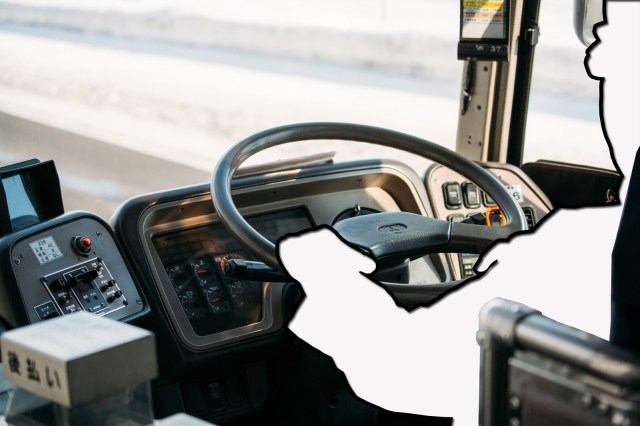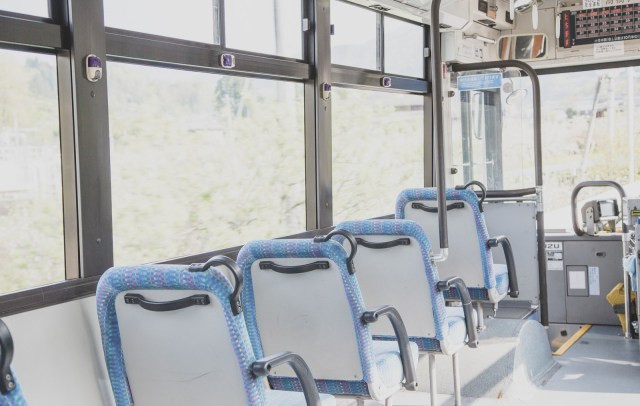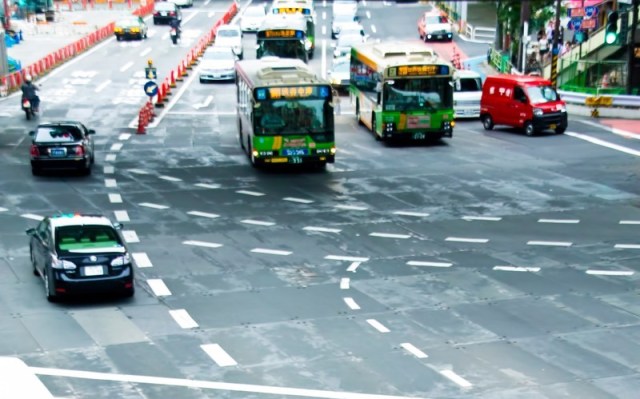
No more worrying about having exact change, but more worrying about having plastic surgery.
Being cautious is certainly wise, but we really seem to be dragging our collective heels when it comes to self-driving vehicles. Considering in Japan reports of cars barreling straight into storefronts seem to happen frequently, it’s hard to imagine even a flawed autonomous driving system doing much worse that humanity as a whole has been.
But steps are being made, and an interesting development has come out of Maebashi City in Gunma Prefecture. More sparsely populated mid-sized cities such as this rely much more on vehicular transport, making it a great testing grounds for a new self-driving bus developed by a council of public transport companies, along with telecom giant NTT Docomo and Gunma Univeristy.
▼ Through testing, it’s hoped that driver-less buses won’t end up being passenger-less buses.
Like any autonomous vehicle, the buses are kitted out with sensors to monitor surrounding traffic and signage and EW also synced with traffic information and geographic information systems through a 5G connection. Testing on a route with Maebashi Station and Chuo Maebashi Station is expected to begin this December.
▼ Hopefully for a truly authentic experience, there’s an algorithm to identify my car in particular and cut it off whenever possible.
Meanwhile, the Ministry of Economy, Trade, and Industry is holding a cross-country testing tour of self-driving buses, along with various regional bus companies. The Hyogo Prefecture leg has just wrapped up in Mita City, in which a six-kilometer (3.7-mile) route had been run completely without a human driver for about a month between late July and late August.
Well, it was almost completely without a human. A minor software glitch required a human to take over for about four days of the trial run. Nevertheless, of the 1,306 passengers who rode the route, half said it was just as good as a human-driven bus when it came to accelerating and turning smoothly, and a further third said it was even better.
However, when it came to stopping, over half of the passengers described it as “bad” and only a quarter called it as good as a human. So while performance was a mixed bag, most walked away impressed overall.
But perhaps the most appealing feature on both the Maebashi and Mita buses is their “face pass” (kao pass) system in which passengers have their face scanned and registered beforehand so that their account gets charged automatically once their face is detected boarding a bus.
▼ Face pass technology has also been tested on subway gates such as on the Osaka Metro lines.
This can make the technology easier to use for seniors who aren’t comfortable with other forms of electronic payment, since they wouldn’t have to lift a finger. As for the rest of us, this also means an end to standing in line to get off the bus while someone – often me – fumbles around for exact change.
Although COVID-19 has led to small changes in scheduling, these test runs are still pushing ahead and the response has been big, with 90 percent of riders on the Kobe test simply there to check it out rather than actually getting from point A to point B. This would suggest that the reality of self-driving buses are probably not too far away.
And throughout all this testing, not one bus has driven into a convenience store window twice… or once for that matter!
Source: Mainichi Shimbun, Kobe Shimbun Next
Top image: Pakutaso (Edited by SoraNews24)
Inset images: Pakutaso 1, 2
● Want to hear about SoraNews24’s latest articles as soon as they’re published? Follow us on Facebook and Twitter!



 Muji designs cool all-weather self-driving shuttle bus, aims to implement it in Finland in 2020
Muji designs cool all-weather self-driving shuttle bus, aims to implement it in Finland in 2020 Heroic bus driver prevents roadside suicide on bridge in China 【Video】
Heroic bus driver prevents roadside suicide on bridge in China 【Video】 Self-driving delivery cars to be used in Japan next year for online shopping
Self-driving delivery cars to be used in Japan next year for online shopping Toyota to begin testing Guardian Angel—an invisible driving companion that could save your life
Toyota to begin testing Guardian Angel—an invisible driving companion that could save your life Japan’s Shachi Bus offers tour with no destination or leaving the bus, but something’s fishy…
Japan’s Shachi Bus offers tour with no destination or leaving the bus, but something’s fishy… Foreigner’s request for help in Tokyo makes us sad for the state of society
Foreigner’s request for help in Tokyo makes us sad for the state of society Japanese city loses residents’ personal data, which was on paper being transported on a windy day
Japanese city loses residents’ personal data, which was on paper being transported on a windy day Seaside scenery, history, and so many desserts on Yokohama’s Akai Kutsu【Japan Loop Buses】
Seaside scenery, history, and so many desserts on Yokohama’s Akai Kutsu【Japan Loop Buses】 Should you add tartar sauce to Japanese curry rice? CoCo Ichi makes diners an unusual offer
Should you add tartar sauce to Japanese curry rice? CoCo Ichi makes diners an unusual offer Red light district sushi restaurant in Tokyo shows us just how wrong we were about it
Red light district sushi restaurant in Tokyo shows us just how wrong we were about it Akihabara pop-up shop sells goods made by Japanese prison inmates
Akihabara pop-up shop sells goods made by Japanese prison inmates Ghibli Park now selling “Grilled Frogs” from food cart in Valley of Witches
Ghibli Park now selling “Grilled Frogs” from food cart in Valley of Witches Princesses, fruits, and blacksmiths: Study reveals the 30 most unusual family names in Japan
Princesses, fruits, and blacksmiths: Study reveals the 30 most unusual family names in Japan Harajuku Station’s beautiful old wooden building is set to return, with a new complex around it
Harajuku Station’s beautiful old wooden building is set to return, with a new complex around it Japanese company starts project to restore Nakagin Capsules to capsule hotel
Japanese company starts project to restore Nakagin Capsules to capsule hotel McDonald’s new Happy Meals offer up cute and practical Sanrio lifestyle goods
McDonald’s new Happy Meals offer up cute and practical Sanrio lifestyle goods Japanese ramen restaurants under pressure from new yen banknotes
Japanese ramen restaurants under pressure from new yen banknotes French Fries Bread in Tokyo’s Shibuya becomes a hit on social media
French Fries Bread in Tokyo’s Shibuya becomes a hit on social media Studio Ghibli releases new action figures featuring Nausicaä of the Valley of the Wind characters
Studio Ghibli releases new action figures featuring Nausicaä of the Valley of the Wind characters New private rooms on Tokaido Shinkansen change the way we travel from Tokyo to Kyoto
New private rooms on Tokaido Shinkansen change the way we travel from Tokyo to Kyoto Tokyo Tsukiji fish market site to be redeveloped with 50,000-seat stadium, hotel, shopping center
Tokyo Tsukiji fish market site to be redeveloped with 50,000-seat stadium, hotel, shopping center All-you-can-drink Starbucks and amazing views part of Tokyo’s new 170 meter-high sky lounge
All-you-can-drink Starbucks and amazing views part of Tokyo’s new 170 meter-high sky lounge Beautiful Ghibli sealing wax kits let you create accessories and elegant letter decorations【Pics】
Beautiful Ghibli sealing wax kits let you create accessories and elegant letter decorations【Pics】 Studio Ghibli releases Kiki’s Delivery Service chocolate cake pouches in Japan
Studio Ghibli releases Kiki’s Delivery Service chocolate cake pouches in Japan New definition of “Japanese whiskey” goes into effect to prevent fakes from fooling overseas buyers
New definition of “Japanese whiskey” goes into effect to prevent fakes from fooling overseas buyers Our Japanese reporter visits Costco in the U.S., finds super American and very Japanese things
Our Japanese reporter visits Costco in the U.S., finds super American and very Japanese things Studio Ghibli unveils Mother’s Day gift set that captures the love in My Neighbour Totoro
Studio Ghibli unveils Mother’s Day gift set that captures the love in My Neighbour Totoro More foreign tourists than ever before in history visited Japan last month
More foreign tourists than ever before in history visited Japan last month New Pokémon cakes let you eat your way through Pikachu and all the Eevee evolutions
New Pokémon cakes let you eat your way through Pikachu and all the Eevee evolutions Sales of Japan’s most convenient train ticket/shopping payment cards suspended indefinitely
Sales of Japan’s most convenient train ticket/shopping payment cards suspended indefinitely Sold-out Studio Ghibli desktop humidifiers are back so Totoro can help you through the dry season
Sold-out Studio Ghibli desktop humidifiers are back so Totoro can help you through the dry season Japanese government to make first change to romanization spelling rules since the 1950s
Japanese government to make first change to romanization spelling rules since the 1950s Ghibli founders Toshio Suzuki and Hayao Miyazaki contribute to Japanese whisky Totoro label design
Ghibli founders Toshio Suzuki and Hayao Miyazaki contribute to Japanese whisky Totoro label design Doraemon found buried at sea as scene from 1993 anime becomes real life【Photos】
Doraemon found buried at sea as scene from 1993 anime becomes real life【Photos】 Tokyo’s most famous Starbucks is closed
Tokyo’s most famous Starbucks is closed One Piece characters’ nationalities revealed, but fans have mixed opinions
One Piece characters’ nationalities revealed, but fans have mixed opinions We asked a Uniqlo employee what four things we should buy and their suggestions didn’t disappoint
We asked a Uniqlo employee what four things we should buy and their suggestions didn’t disappoint Narita Airport shuttle buses – Cheaper than the train, but which bus is best?
Narita Airport shuttle buses – Cheaper than the train, but which bus is best? University of Tokyo lecturer suggests giving cars big cartoon eyes will make them safer
University of Tokyo lecturer suggests giving cars big cartoon eyes will make them safer China’s revolutionary elevated bus takes its first ride
China’s revolutionary elevated bus takes its first ride Bus driver in Yokohama City announces warm message to the mother of a screaming child
Bus driver in Yokohama City announces warm message to the mother of a screaming child China’s new bus design looks like a car-eating monster 【Video】
China’s new bus design looks like a car-eating monster 【Video】 No water, no cooking oil, no yogurt: The new strict bus rules in Urumqi, China
No water, no cooking oil, no yogurt: The new strict bus rules in Urumqi, China Fueled by road rage, two public transport buses in China collide【Video】
Fueled by road rage, two public transport buses in China collide【Video】 This Chinese Tesla killer has a fish tank in the back seat!
This Chinese Tesla killer has a fish tank in the back seat! Tokyo bus operator adds free-to-use USB chargers for tech-loving passengers
Tokyo bus operator adds free-to-use USB chargers for tech-loving passengers Human hair from India helps make Japanese buses more efficient
Human hair from India helps make Japanese buses more efficient Sword of one of Japan’s last samurai discovered in house in America
Sword of one of Japan’s last samurai discovered in house in America Samsung prototype ‘Safety Truck’ uses all-weather screens to make driving safer, maybe
Samsung prototype ‘Safety Truck’ uses all-weather screens to make driving safer, maybe One thing NOT to do in Kyoto if you’re headed there during the vacation period
One thing NOT to do in Kyoto if you’re headed there during the vacation period Kyoto massage parlor would like to offer you a head rub on a self-driving tatami reed floor【Vid】
Kyoto massage parlor would like to offer you a head rub on a self-driving tatami reed floor【Vid】 Japan’s ultra-classy overnight bus gives you your own sleeping pod【Photos】
Japan’s ultra-classy overnight bus gives you your own sleeping pod【Photos】 Japanese transport group aims to set up public ropeway transit system by 2025
Japanese transport group aims to set up public ropeway transit system by 2025
Leave a Reply